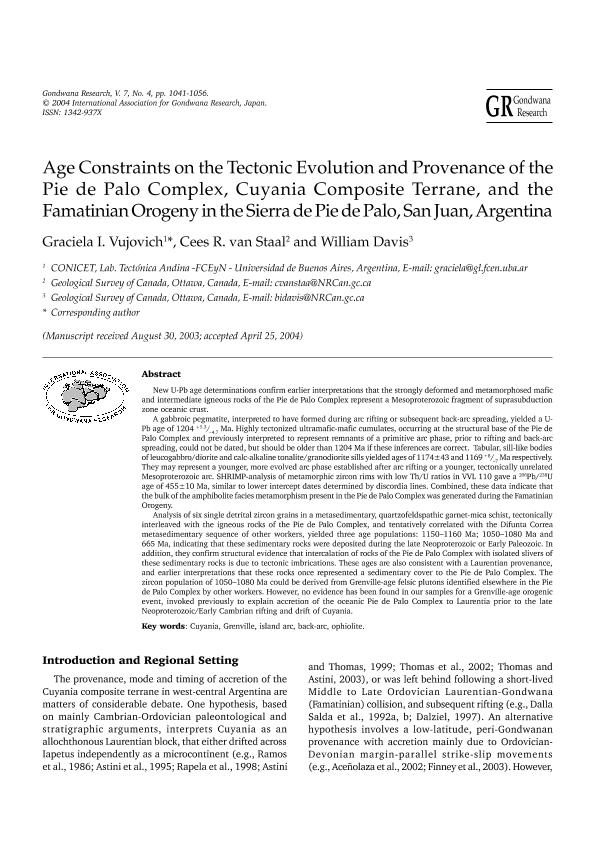Mostrar el registro sencillo del ítem
dc.contributor.author
Vujovich, Graciela Irene

dc.contributor.author
van Staal, Cees R.
dc.contributor.author
Davis, William
dc.date.available
2020-01-06T20:42:17Z
dc.date.issued
2004-12
dc.identifier.citation
Vujovich, Graciela Irene; van Staal, Cees R.; Davis, William; Age constraints on the tectonic evolution and provenance of the Pie de Palo Complex, Cuyania composite terrane and the Famatinian orogeny in the Sierra de Pie de Palo, San Juan, Argentina; Elsevier Science; Gondwana Research; 7; 4; 12-2004; 1041-1056
dc.identifier.issn
1342-937X
dc.identifier.uri
http://hdl.handle.net/11336/93714
dc.description.abstract
New U-Pb age determinations confirm earlier interpretations that the strongly deformed and metamorphosed mafic and intermediate igneous rocks of the Pie de Palo Complex represent a Mesoproterozoic fragment of suprasubduction zone oceanic crust. A gabbroic pegmatite, interpreted to have formed during arc rifting or subsequent back-arc spreading, yielded a U-Pb age of 1204 +5.3/-4. 7 Ma. Highly tectonized ultramafic-mafic cumulates, occurring at the structural base of the Pie de Palo Complex and previously interpreted to represent remnants of a primitive arc phase, prior to rifting and back-arc spreading, could not be dated, but should be older than 1204 Ma if these inferences are correct. Tabular, sill-like bodies of leucogabbro /diorite and calc-alkaline tonalite/granodiorite sills yielded ages of 1174±43 and 1169+1/-7 Ma respectively. They may represent a younger, more evolved arc phase established after arc rifting or a younger, tectonically unrelated Mesoproterozoic arc. SHRIMP-analysis of metamorphic zircon rims with low Th/U ratios in VVL 110 gave a 206Pb/238U age of 455 ± 10 Ma, similar to lower intercept dates determined by discordia lines. Combined, these data indicate that the bulk of the amphibolite facies metamorphism present in the Pie de Palo Complex was generated during the Famatinian Orogeny. Analysis of six single detrital zircon grains in a metasedimentary, quartzofeldspathic garnet-mica schist, tectonically interleaved with the igneous rocks of the Pie de Palo Complex, and tentatively correlated with the Difunta Correa metasedimentary sequence of other workers, yielded three age populations: 1150-1160 Ma; 1050-1080 Ma and 665 Ma, indicating that these sedimentary rocks were deposited during the late Neoproterozoic or Early Paleozoic. In addition, they confirm structural evidence that intercalation of rocks of the Pie de Palo Complex with isolated slivers of these sedimentary rocks is due to tectonic imbrications. These ages are also consistent with a Laurentian provenance, and earlier interpretations that these rocks once represented a sedimentary cover to the Pie de Palo Complex. The zircon population of 1050-1080 Ma could be derived from Grenville-age felsic plutons identified elsewhere in the Pie de Palo Complex by other workers. However, no evidence has been found in our samples for a Grenville-age orogenic event, invoked previously to explain accretion of the oceanic Pie de Palo Complex to Laurentia prior to the late Neoproterozoic/Early Cambrian rifting and drift of Cuyania.
dc.format
application/pdf
dc.language.iso
eng
dc.publisher
Elsevier Science

dc.rights
info:eu-repo/semantics/openAccess
dc.rights.uri
https://creativecommons.org/licenses/by-nc-sa/2.5/ar/
dc.subject
BACK-ARC
dc.subject
CUYANIA
dc.subject
GRENVILLE
dc.subject
ISLAND ARC
dc.subject
OPHIOLITE
dc.subject.classification
Geología

dc.subject.classification
Ciencias de la Tierra y relacionadas con el Medio Ambiente

dc.subject.classification
CIENCIAS NATURALES Y EXACTAS

dc.title
Age constraints on the tectonic evolution and provenance of the Pie de Palo Complex, Cuyania composite terrane and the Famatinian orogeny in the Sierra de Pie de Palo, San Juan, Argentina
dc.type
info:eu-repo/semantics/article
dc.type
info:ar-repo/semantics/artículo
dc.type
info:eu-repo/semantics/publishedVersion
dc.date.updated
2019-12-12T14:53:12Z
dc.journal.volume
7
dc.journal.number
4
dc.journal.pagination
1041-1056
dc.journal.pais
Países Bajos

dc.journal.ciudad
Amsterdam
dc.description.fil
Fil: Vujovich, Graciela Irene. Consejo Nacional de Investigaciones Científicas y Técnicas. Oficina de Coordinación Administrativa Ciudad Universitaria. Instituto de Estudios Andinos "Don Pablo Groeber". Universidad de Buenos Aires. Facultad de Ciencias Exactas y Naturales. Instituto de Estudios Andinos "Don Pablo Groeber"; Argentina
dc.description.fil
Fil: van Staal, Cees R.. Geological Survey of Canada; Canadá
dc.description.fil
Fil: Davis, William. Geological Survey of Canada; Canadá
dc.journal.title
Gondwana Research

dc.relation.alternativeid
info:eu-repo/semantics/altIdentifier/url/https://www.sciencedirect.com/science/article/pii/S1342937X05710832
dc.relation.alternativeid
info:eu-repo/semantics/altIdentifier/doi/https://doi.org/10.1016/S1342-937X(05)71083-2
Archivos asociados
